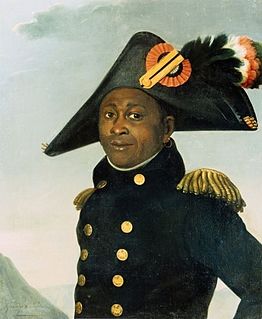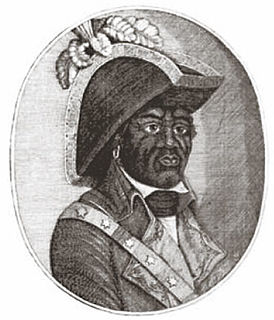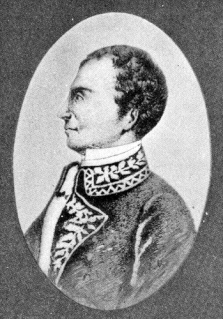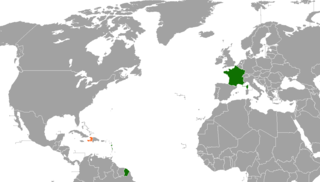Siege
Troops loyal to the commissioners commanded by generals Lassale, European, and Beauvais, mulatto, then lay siege to Port-au-Prince. For their part, the representatives Sonthonax and Polverel establish their base at the port of Saint-Marc, they take the head of the navy and attack on the side of the sea. On April 12 the forces of the commissioners launch a general attack by sea and land. The commissioners ship is badly damaged by rebel cannons and a fire breaks out, but it is extinguished.
Intensely bombarded with 4,000 to 5,000 bullets, Port-au-Prince capitulates on April 14, 1793. Borel, the leader of the insurgents, fled to Jamaica, his slaves are disarmed and return to their plantations.

François-Dominique Toussaint Louverture was a Haitian general and the most prominent leader of the Haitian Revolution. During his life, Louverture first fought against the French, then for them, and then finally against France again for the cause of Haitian independence. As a revolutionary leader, Louverture displayed military and political acumen that helped transform the fledgling slave rebellion into a revolutionary movement. Louverture is now known as the "Father of Haiti".

Jean-Jacques Dessalines was a leader of the Haitian Revolution and the first ruler of an independent Haiti under the 1805 constitution. Under Dessalines, Haiti became the first country to permanently abolish slavery. Initially regarded as governor-general, Dessalines was later named Emperor of Haiti as Jacques I (1804–1806) by generals of the Haitian Revolution Army and ruled in that capacity until being assassinated in 1806. He is the father of the nation Haiti.

Alexandre Sabès Pétion was the first president of the Republic of Haiti from 1807 until his death in 1818. He is acknowledged as one of Haiti's founding fathers; a member of the revolutionary quartet that also includes Toussaint Louverture, Jean-Jacques Dessalines, and his later rival Henri Christophe. Regarded as an excellent artilleryman in his early adulthood, Pétion would distinguish himself as an esteemed military commander with experience leading both French and Haitian troops. The 1802 coalition formed by him and Dessalines against French forces led by Charles Leclerc would prove to be a watershed moment in the decade-long conflict, eventually culminating in the decisive Haitian victory at the Battle of Vertières in 1803.

The Haitian Revolution was a successful insurrection by self-liberated slaves against French colonial rule in Saint-Domingue, now the sovereign state of Haiti. The revolt began on 22 August 1791, and ended in 1804 with the former colony's independence. It involved black, biracial, French, Spanish, British, and Polish participants—with the ex-slave Toussaint Louverture emerging as Haiti's most charismatic hero. The revolution was the only slave uprising that led to the founding of a state which was both free from slavery and ruled by non-whites and former captives. It is now widely seen as a defining moment in the history of the Atlantic World.

Léger-Félicité Sonthonax was a French abolitionist and Jacobin before joining the Girondist party, which emerged in 1791. During the French Revolution, he controlled 7,000 French troops in Saint-Domingue during part of the Haitian Revolution. His official title was Civil Commissioner. From September 1792 to December 1795, he was the de facto ruler of Saint-Domingue's non-slave populace. Within a year of his appointment, his powers were considerably expanded by the Committee of Public Safety. He was recalled in 1795 largely due to the resurgence of conservative politics in France. Sonthonax believed that Saint-Domingue's whites were royalists or separatists, so he attacked the military power of the white settlers and by doing so alienated the colonial settlers from their government. Many gens de couleur asserted that they could form the military backbone of Saint-Domingue if they were given rights, but Sonthonax rejected this view as outdated in the wake of the August 1791 slave uprising. He believed that Saint-Domingue would need ex-slave soldiers among the ranks of the colonial army if it was to survive. On August 1793, he proclaimed freedom for all slaves in the north province. His critics allege that he was forced into ending slavery in order to maintain his own power.

Georges Biassou was an early leader of the 1791 slave rising in Saint-Domingue that began the Haitian Revolution. With Jean-François and Jeannot, he was prophesied by the vodou priest, Dutty Boukman, to lead the revolution.

Benoit Joseph André Rigaud was the leading mulatto military leader during the Haitian Revolution. Among his protégés were Alexandre Pétion and Jean-Pierre Boyer, both future presidents of Haïti.
Étienne Polverel (1740–1795) was a French lawyer, aristocrat, and revolutionary. He was a member of the Jacobin club. In 1792, he and Léger Félicité Sonthonax were sent to Saint-Domingue to suppress a slave revolt. Polverel was an abolitionist and after a few years he had emancipated the slaves of the colony and given them political equality.

Prince Jean-Louis Michel Pierrot, Baron of Haïti was a career officer general in the Haitian Army who also served as President of Haiti from 16 April 1845 to 1 March 1846.
The War of Knives, also known as the War of the South, was a civil war from June 1799 to July 1800 between the Haitian revolutionary Toussaint Louverture, a black ex-slave who controlled the north of Saint-Domingue, and his adversary André Rigaud, a mixed-race free person of color who controlled the south. Louverture and Rigaud fought over de facto control of the French colony of Saint-Domingue during the war. Their conflict followed the withdrawal of British forces from the colony during the early stages of the Haitian Revolution. The war resulted in Toussaint taking control of the entirety of Saint-Domingue, and Rigaud fleeing into exile.

France–Haiti relations are foreign relations between France and Haiti. Both nations are members of the Organisation internationale de la Francophonie, United Nations, and the World Trade Organization.
Macaya, was a Kongolese-born Haitian revolutionary military leader. Macaya was one of the first black rebel leaders in Saint-Domingue to ally himself with the French Republican commissioners Sonthonax and Polverel. He helped to lead forces that recaptured Cap-Français on behalf of the French Republicans.
The siege of Port-au-Prince was an engagement that took place during the Haitian Revolution.

The Battle of Croix-des-Bouquets took place during the Haitian Revolution.
The Battle of Saint-Raphaël took place during the Haitian Revolution.

The Battle of Cap-Français took place from 20 to 22 June 1793 during the Haitian Revolution.
The Battle of Port-Républicain took place during the Haitian Revolution (1791-1804).
Étienne Maynaud de Bizefranc de Laveaux was a French general who was Governor of Saint-Domingue from 1793 to 1796 during the French Revolution. He ensured that the law that freed the slaves was enforced, and supported the black leader Toussaint Louverture, who later established the independent republic of Haiti. After the Bourbon Restoration he was Deputy for Saône-et-Loire from 1820 to 1823.

François-Thomas Galbaud du Fort was a French general who was briefly governor-general of Saint-Domingue. He arrived at a time when the planters were hostile to the new French First Republic with its ideals of equality of all men, when many slaves had left the plantations and were fighting for freedom, and when the Spanish in neighboring Santo Domingo were at war with France. He started an uprising in the northern city of Cap-Français against the commissioners who represented the Republic. After violent clashes between white supporters of Galbaud and mulattoes and newly freed slaves who supported the commissioners he was forced to flee to the United States with many of the dissident planters and their families.
In 1789 is made the Declaration of the Rights of Man and of the Citizen, set by France's National Constituent Assembly. In 1791, the enslaved Africans of Saint-Domingue began the Haitian Revolution, aimed at the overthrow of the colonial regime.










